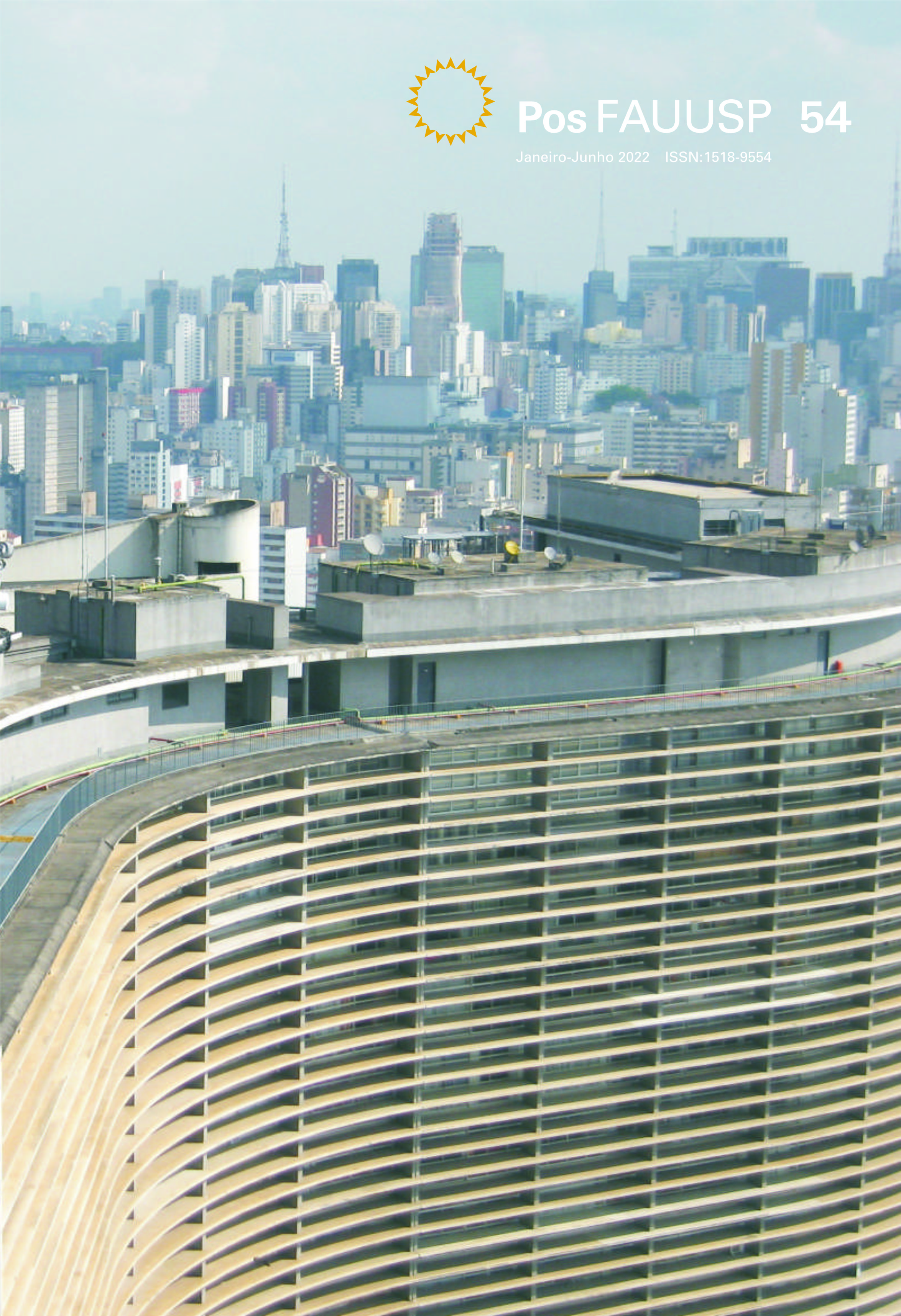The Construction of Architectural Ideas
DOI:
https://doi.org/10.11606/issn.2317-2762.posfauusp.2022.184795Palabras clave:
Public oratory , Monument, Popular devotionResumen
This work discusses how ideas are constructed in the design process of architecture projects, identifying what enables their emergence, development, selection and elimination. A qualitative and exploratory research method was used. The basic assumption is that ideas are mainly the result of knowledge, although influenced by subjective factors of the designer: criticism acts as a filter of ideation, thus governing the process of selection and disposal of ideas. Theories, assumptions and arguments of other researchers on the subject of creativity were confronted with the findings presented. This revealed a pattern in the construction of ideas during architectural design processes that puts into question the theory in which ideas arise from the interaction between designers and their sketches.
Descargas
Referencias
ARCHER, Bruce. Systematic Method for Designers. In: CROSS, Nigel (Org.). Developments in Design Methodology. New York: John Wiley & Sons, 1984. p. 57 – 82.
CHAI, Kah-Hin, XIAO, Xin. Understanding design research: a bibliometric analysis of Design Studies (1996 – 2010). Design Studies.Vol.23, n.3, jan. 2012. p. 24-43. DOI:https://www.sciencedirect.com/science/article/abs/pii/S0142694X11000524?via%3Dihub
CROSS, Nigel. Designerly Ways of Knowing. London: Springer, 2006. 114p.
CROSS, Nigel (Org.). Developments in Design Methodology. New York: John Wiley & Sons, 1984. 357p.
DARKE, Jane. The Primary Generator and the Design Process. In: CROSS, Nigel (Org.). Developments in Design Methodology. New York: John Wiley & Sons, 1984. p. 175 - 188.
DIETRICH, Arne (2016). Interview given by Arne Dietrich. nov. 2016. Available in <https://www.youtube.com/watch?v=Krd4pbdxBN0>. Access in: feb, 3rd. 2019.
DUBBERLY, Hugh; PANGARO, Paul. Cybernetics and Design: Conversations for Action. Cybernetics and Human Knowing. Vol. 22, nos. 2-3, 2015, p. 73-82. DOI:https://link.springer.com/chapter/10.1007%2F978-3-030-18557-2_4
DUNBAR, K. How scientists think: On-line creativity and conceptual change in science. In: WARD, T.B., SMITH, S. M. e VAID, J. (Orgs.), Creative thought: An investigation of conceptual structures and processes. Washington, DC: American Psychological Association, 1997. p. 461 - 494.
ERICSSON, K. A.; SIMON H. A. Protocol analysis: Verbal reports as data. Cambridge: MIT Press. 1993. 500p.
GERO, John S. ; TANG, Hsien-Hui. The Differences Between Retrospective and concurrent protocol in revealing the process-oriented aspects of the design process. Design Studies. Vol. 22, n. 3, 2001, p. 283-295. DOI: https://doi.org/10.1016/S0142-694X(00)00030-2
GOLDSCHMIDT, Gabriela. The Dialectics of Sketching. Creativity Research Journal. Vol.4, n.2, 1991, p. 123 - 143. DOI:https://www.tandfonline.com/doi/abs/10.1080/10400419109534381
HILLIER, Bill. Space is the Machine: A Configurational Theory of Architecture. London: Space Syntax, 2007. 355p.
HILLIER, Bill, MUSGROVE, John e O’SULLIVAN, Pat. Knowledge and Design. In: MITCHELL, W.J. Environmental design: research and practice 2. Proceedings of the EDRA 3/AR 8 Conference, 1972. p.29-3-1 –p.29-3-14.
KAUFMAN, James C.; Robert J. STERNBERG. The Cambridge Handbook of Creativity. Cambridge: Cambridge University Press, 2010.
LANDAY, J A; MYERS, B. Interactive Sketches for the early stages of user interface design. In: Human Factors in Computing Systems, CHI ‘95 Conference Proceedings. 1995, p. 43-50.
LAWSON, Bryan. How Designers Think. Cambridge: Cambridge University Press, 1990. 243p.
LLOYD, Peter; LAWSON, Bryan; SCOTT, Peter. Can Concurrent Verbalizations Reveal Design Cognition? Design Studies. Vol. 16, n. 2, 1995, p. 237-259. DOI: https://doi.org/10.1016/0142-694X(94)00011-2
LOCHER, Paul J. How Does a Visual Artist Create an Artwork? In: KAUFMAN, James C.; Robert J. STERNBERG. The Cambridge Handbook of Creativity. Cambridge: Cambridge University Press, 2010. p. 131 – 144.
MALARD, Maria Lúcia. Projeto arquitetônico e pensamento científico. Na Gênese das racionalidades modernas. Belo Horizonte: Editora UFMG, 2013, vol. 1, p. 259-274.
MALARD, Maria Lúcia. O futuro do projeto em arquitetura e urbanismo: ensino e pesquisa. In: CAMPOMORI, Mauricio José Laguardia. (Org.). Aprender fazendo: ensaios sobre o ensino de projeto. Belo Horizonte: Escola de Arquitetura da UFMG, 2018, p. 95-110. Pos FAUUSP 13 Pos FAUUSP, São Paulo, v. 29, n. 54, e184795, jan-jun 2022.
OSTROWER, Fayga. Criatividade e Processos de Criação. 30 ed. Rio de Janeiro: Ed. Vozes, 2018. 186p.
POPPER, Karl. Conjecturas e Refutações. 4 ed. Brasília: Ed. UnB, 1972.
RITTEL, Horst. On the Planning Crisis: Systems Analysis of the “First and Second Generations”. Bedriftsøkonomen. Oslo. n.8, 1972, p.390 - 396.
RUNCO, Mark A. Divergent Thinking, Creativity and Ideation. In: KAUFMAN, James C.; Robert J. STERNBERG. The Cambridge Handbook of Creativity. Cambridge: Cambridge University Press, 2010. p. 415 – 446.
SCHÖN, Donald. The Reflective Practitioner: How Professionals Think in Action. New York: Basic Books, 1983. 376p.
SUWA, Masaki; TVERSKY, Barbara. What do architects and students perceive in their design sketches? A protocol analysis. Design Studies. Vol. 18, n. 4, 1997, p. 385-403. DOI: https://doi.org/10.1016/S0142-694X(97)00008-2
WEISBERG, R. Creativity and Knowledge: A challenge to Theories. In: KAUFMAN, James C.; Robert J. STERNBERG. The Cambridge Handbook of Creativity. Cambridge: Cambridge University Press, 2010. p. 226 – 248.
Descargas
Publicado
Número
Sección
Licencia
Derechos de autor 2022 Isabel Caldeira Brant, Maria Lúcia Malard

Esta obra está bajo una licencia internacional Creative Commons Atribución-SinDerivadas 4.0.
La revista Pós. del programa de postgrado FAUUSP está licenciada con una licencia Creative Commons Attribution 4.0 International License.
El titular de los derechos de autor es el autor del artículo. La revista Pós. sólo exige que la publicación del artículo sea inédita. El autor tiene el derecho de divulgar su artículo según su conveniencia debiendo citar la revista.
La revista Pós. autoriza la republicación de sus artículos desde que debidamente citada fuente y autoría.
DIADORIM - Diretório de Políticas Editoriais













